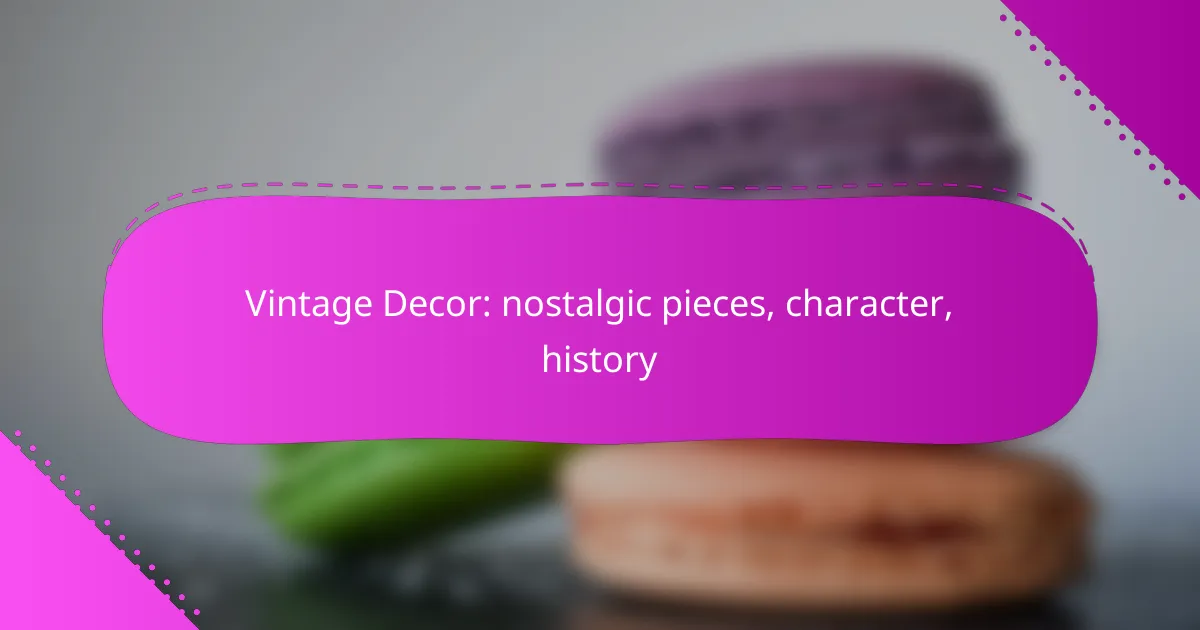Vintage decor brings a touch of nostalgia and character to any space, showcasing pieces that tell stories from different eras. By incorporating these unique items, you not only enhance your home’s aesthetic but also embrace sustainable practices and potential investment value. Blending vintage elements with modern design can create a harmonious and inviting atmosphere that reflects your personal history.

Where to find vintage decor in the UK?
In the UK, vintage decor can be found in various places, including online platforms, specialty shops, and antique fairs. Each option offers unique pieces that reflect different eras and styles, catering to diverse tastes and budgets.
Online marketplaces like eBay and Etsy
Online marketplaces such as eBay and Etsy are excellent sources for vintage decor. They feature a vast array of items from sellers across the UK, allowing you to browse and compare prices easily.
When shopping online, pay attention to seller ratings and reviews to ensure a reliable purchase. Look for items that include detailed descriptions and clear photographs to avoid surprises upon delivery.
Specialty vintage shops in London
London is home to numerous specialty vintage shops that offer curated selections of decor. Areas like Camden Market and Portobello Road are particularly known for their eclectic finds, ranging from mid-century furniture to retro accessories.
Visiting these shops allows you to inspect items in person and negotiate prices. Many shops also host themed events or sales, so check their websites or social media for updates on special offers.
Antique fairs across the UK
Antique fairs are popular venues for discovering vintage decor throughout the UK. These events typically feature multiple vendors showcasing a variety of items, from furniture to collectibles, often at competitive prices.
To make the most of your visit, arrive early for the best selection and be prepared to haggle. Keep an eye out for local fairs, which can be found in community centers or larger venues, and check their schedules online for dates and locations.

What are the benefits of vintage decor?
Vintage decor offers a range of benefits, including unique aesthetics, sustainability, and potential investment value. Incorporating nostalgic pieces can enhance the character of a space while also promoting eco-friendly practices.
Unique character and charm
Vintage decor brings a distinctive character and charm that modern pieces often lack. Each item carries its own history, telling stories that can add depth to your home or office environment.
For example, a mid-century modern chair or a Victorian-era lamp can serve as conversation starters, showcasing your personal style and appreciation for craftsmanship. These pieces often feature unique designs and materials that are hard to find in contemporary furnishings.
Eco-friendly and sustainable choice
Choosing vintage decor is an eco-friendly and sustainable option, as it promotes recycling and reduces waste. By opting for pre-owned items, you help decrease the demand for new manufacturing, which often involves significant resource consumption and pollution.
Additionally, many vintage pieces are made from durable materials that stand the test of time, further contributing to sustainability. Look for items that are in good condition or can be easily restored to minimize environmental impact.
Investment potential over time
Vintage decor can also serve as a smart investment, as certain pieces appreciate in value over time. Items from specific eras or renowned designers often become sought after, making them valuable collectibles.
When considering investment potential, focus on well-maintained items with provenance or those that are part of a recognized trend. Research market values and trends to make informed purchases that could yield returns in the future.

How to style vintage decor in modern homes?
Styling vintage decor in modern homes involves blending nostalgic pieces with contemporary design elements to create a cohesive and inviting space. Focus on selecting items that reflect your personal history while ensuring they harmonize with modern aesthetics.
Mixing vintage with contemporary pieces
To effectively mix vintage and contemporary pieces, start by choosing a few standout vintage items that resonate with your style. Pair these with modern furniture that complements their character, such as a sleek sofa alongside an antique coffee table.
Consider the scale and proportion of each piece. A large, ornate vintage mirror can enhance a minimalist wall, while a mid-century chair can add warmth to a modern dining area. Balance is key—ensure that neither style overwhelms the other.
Creating focal points with statement items
Statement items are crucial in vintage decor as they draw attention and set the tone for the room. Choose a bold vintage piece, like an eye-catching chandelier or an intricately designed sideboard, to serve as a focal point.
Position these items strategically within the space. For instance, place a vintage armchair in a well-lit corner or use a decorative trunk as a coffee table to invite conversation. Surround these focal points with simpler, contemporary elements to maintain visual interest without clutter.
Using color palettes that complement vintage styles
Color palettes play a significant role in enhancing vintage decor. Opt for muted tones, earthy shades, or pastel hues that evoke nostalgia and pair well with vintage items. Colors like dusty rose, olive green, or soft mustard can create a warm, inviting atmosphere.
When selecting colors, consider the overall mood you wish to achieve. Use vintage textiles, such as patterned rugs or curtains, to introduce color while maintaining harmony with modern furnishings. A well-chosen color palette can seamlessly blend the old with the new, enhancing the character of your home.

What are popular vintage decor styles?
Popular vintage decor styles evoke nostalgia and charm, each with unique characteristics and historical significance. These styles often blend aesthetics from different eras, allowing for creative expression in home design.
Mid-century modern
Mid-century modern decor, popular from the 1940s to the 1960s, is characterized by clean lines, organic forms, and a focus on functionality. This style often incorporates materials like wood, metal, and glass, creating a seamless connection between indoor and outdoor spaces.
To achieve a mid-century modern look, consider using furniture with tapered legs, bold colors, and geometric patterns. Iconic pieces include Eames chairs and teak sideboards, which can often be found at vintage shops or online marketplaces.
Art Deco
Art Deco emerged in the 1920s and 1930s, known for its luxurious materials, bold geometric shapes, and rich colors. This style reflects the glamour of the Jazz Age, often incorporating elements like chrome, glass, and exotic woods.
To incorporate Art Deco into your decor, look for statement pieces such as mirrored furniture, ornate lighting fixtures, and vibrant textiles. Mixing these elements can create a sophisticated and opulent atmosphere in your home.
Shabby chic
Shabby chic decor combines vintage charm with a soft, romantic aesthetic, often featuring distressed furniture and pastel colors. This style emphasizes comfort and a lived-in feel, making spaces inviting and cozy.
To create a shabby chic environment, focus on layering textures with soft fabrics, floral patterns, and vintage accessories. Thrift stores and flea markets are great places to find unique items that can be easily upcycled to fit this style.

How to care for vintage decor items?
Caring for vintage decor items involves regular maintenance, appropriate cleaning methods, and proper storage to preserve their character and history. Understanding the specific needs of different materials is essential for ensuring longevity and preventing damage.
Cleaning techniques for different materials
Different materials require tailored cleaning techniques to avoid damage. For wood, use a soft, lint-free cloth and a mild soap solution, avoiding harsh chemicals that can strip finishes. Metal items may benefit from a gentle polish, while glass can be cleaned with a vinegar-water solution for a streak-free shine.
For fabrics, check for any labels or tags that provide care instructions. Hand washing or dry cleaning may be necessary, depending on the fabric type. Always test a small, inconspicuous area first to ensure no adverse reactions occur.
Storage tips to prevent damage
Proper storage is crucial for protecting vintage decor items from environmental factors. Keep items in a cool, dry place away from direct sunlight, which can fade colors and damage materials. Use acid-free tissue paper for wrapping delicate items and avoid stacking heavy pieces on top of each other.
Consider using display cases or cabinets with UV-filtering glass to protect items while showcasing them. Regularly check stored items for signs of pests or moisture, and address any issues immediately to prevent further damage.
Restoration options for worn pieces
Restoration can breathe new life into worn vintage decor, but it should be approached with caution. For minor scratches on wood, a touch-up marker or furniture polish can often suffice. However, for significant damage, consulting a professional restorer may be the best option to maintain authenticity.
When restoring fabrics, consider reupholstering or using fabric-safe dyes to refresh colors. Always use materials that match the original as closely as possible to preserve the item’s historical integrity. If unsure, seek expert advice to avoid diminishing the piece’s value.

What are the historical influences on vintage decor?
Vintage decor is shaped by various historical influences that reflect the cultural, social, and technological changes over time. Key periods such as the Industrial Revolution and significant art movements have left lasting marks on the styles and materials used in vintage pieces.
Impact of the Industrial Revolution
The Industrial Revolution, which began in the late 18th century, drastically changed production methods, leading to mass manufacturing of furniture and decor. This shift made decorative items more accessible to the general public, allowing for a broader range of styles to emerge.
As factories produced items in bulk, design elements became standardized, yet some artisans maintained traditional craftsmanship, creating unique pieces that are now highly sought after. Items like cast iron furniture and patterned textiles became popular, reflecting both functionality and aesthetic appeal.
Art movements and their styles
Various art movements, such as Art Nouveau, Arts and Crafts, and Mid-Century Modern, have significantly influenced vintage decor. Art Nouveau, characterized by its organic forms and intricate designs, introduced a sense of elegance and nature into home decor during the late 19th and early 20th centuries.
The Arts and Crafts movement emphasized handmade quality and natural materials, promoting a return to craftsmanship in response to industrialization. Mid-Century Modern, emerging in the mid-20th century, focused on simplicity and functionality, with clean lines and minimal ornamentation, which continues to resonate in contemporary vintage decor.
